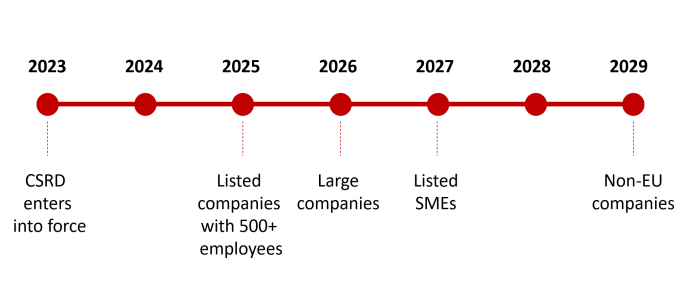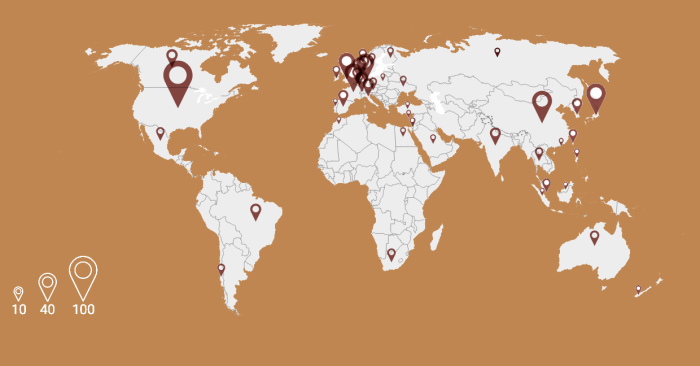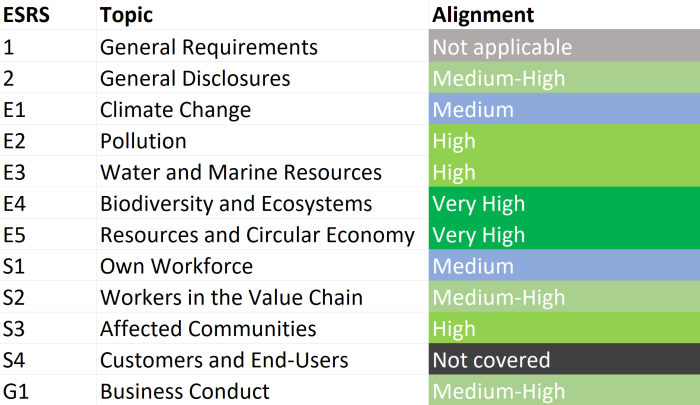Using the Nature Benchmark to monitor the CSRD’s impact and effectiveness

The current set of EU reporting legislation will radically transform the information available on the impact of corporate activities on the environment and society. This information needs to be used to transform company behaviour and head towards a more sustainable future. To ensure these rules lead to impact and not just more ESG data, we need everyone, everywhere to act all at once. The World Benchmarking Alliance’s (WBA’s) benchmarks can help with this.
What is the EU’s new reporting legislation?
In November 2022, European Union legislators officially adopted the final overall reporting standards, aptly called “European Sustainable Reporting Standards (ESRS), as the key tool to implement the Corporate Sustainability Reporting Directive (CSRD) . This landmark directive aims to provide a more comprehensive picture of companies’ sustainability performance by requiring large businesses and listed SMEs mainly operating in the EU to report both their risks and impacts on topics ranging from climate and biodiversity, to governance and human rights.
The CSRD builds on and significantly expands the scope of its predecessor, the Non-Financial Reporting Directive (NFRD). Nearly 50,000 EU companies and, for the first time, at least 10,000 non-EU companies, who are operating in the EU, will be legally mandated to report on their sustainability impacts. This deluge of data is potentially a game-changer as to date the lack of disclosure has been a key barrier for holding companies accountable for their sustainability efforts.
In terms of timeline, the CSRD came into effect in January 2023 and will be rolled out progressively, starting with large EU companies and then finally covering large non-EU companies. The first companies will need to publish their CSRD-aligned reports in 2025, based on their 2024 data. Non-EU companies should also start preparing as their first reports are due in 2029.

How can the Nature Benchmark help with the assessment of CSRD’s effectiveness?
WBA’s Nature Benchmark assesses approximately 800 companies with the largest impact on nature globally spanning across 14 industries such as food and agriculture, apparel and mining. Among the companies assessed, at least 70% are in scope of the CSRD.
As all the information used for the Nature Benchmark is publicly available, the benchmark makes it easy to access, understand and analyse these companies’ level of disclosure, performance against their peers as well as areas for improvement.
The global impact of CSRD is also something captured by the benchmark. About half of the companies in our analysis are headquartered outside of the EU but in scope of the CSRD, which brings a strong opportunity to grasp non-EU companies’ level of preparedness for the directive.

The information made available through our benchmark is well aligned with the specific indicators required by the CSRD through the European Sustainability Reporting Standards (ESRS). The mapping between the Nature Benchmark methodology and the ESRS shows clear areas of overlap, especially on environmental topics such as biodiversity and ecosystems. This profound interoperability allows anyone to draw powerful insights. For example, based on our data, Circle Economy found that less than 22% of companies are ready to report quantitatively on circular economy for the new legislation.

Overall, there is a strong complementarity between both the benchmark and the CSRD. The CSRD opens up a wealth of information through mandatory disclosure while the Nature Benchmark provides an analysis of these disclosures and reveal the corporate sustainability state of play. The benchmark thus allows all stakeholders to understand what they can expect from the CSRD disclosures, enabling them to easily understand as well as use them in their own decision-making and analysis.
How to use the Nature Benchmark toolkit
The Nature Benchmark can shed light on the CSRD implementation and offers a convenient baseline to evaluate the detail of disclosure from many of the most influential companies. While the amount of disclosure is bound to explode, the newly available data is not necessarily meaningful in itself and requires a proper lens to be translated into insight. To fully use the potential of the benchmark as a CSRD tracker, we provide three essential elements as a publicly available toolkit:
These tools enable stakeholders to gain a deeper understanding of our data and to draw their own insights regarding this new key legislation. For instance, if one wants to understand the current CSRD-readiness of Swiss companies, they can use the company mapping, select country of incorporation as ’Switzerland’ and filter the companies marked as likely to be in scope of the CSRD. From there, all that is left is to draw the results of these companies from the dataset and start the analysis.
Similarly, should one want detailed insight on biodiversity and ESRS E4 regarding the assessed companies, they can use the ESRS mapping to find the relevant indicators in our assessments and then dive into the relevant section of the dataset. The tools can also be combined in multiple ways suiting the specific results one is looking for, for example Chinese companies under the CSRD and performance on governance indicators.
Benchmarking as a collaborative accountability process
No one organisation can hold all companies accountable on their sustainability efforts. Collaboration is key to close the gap on corporate accountability and our publicly available data enables others to do more to strengthen the entire accountability process. The Nature Benchmark can serve as a collective accountability mechanism to ensure corporations truly head toward a nature-positive future.
Interested in collaborating? Get in touch with Nicolas Sauviat.